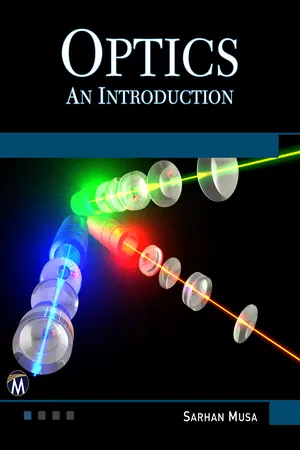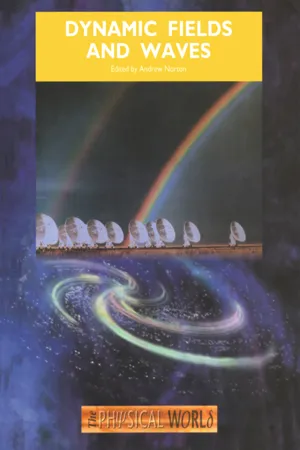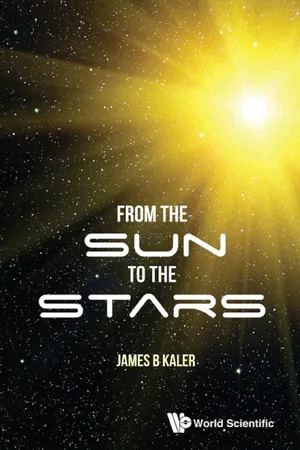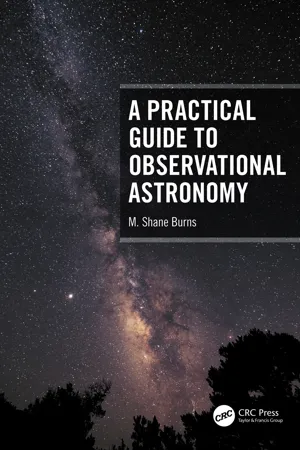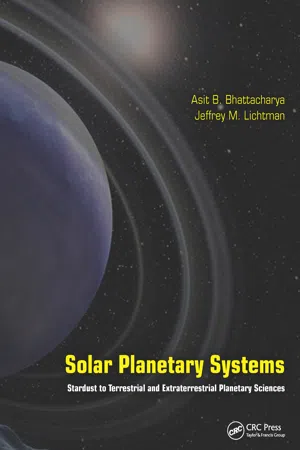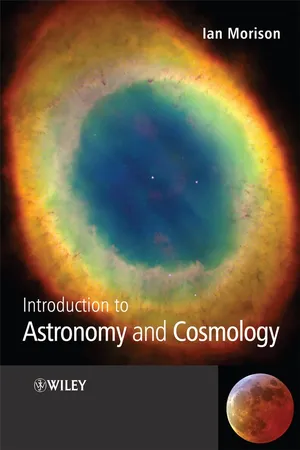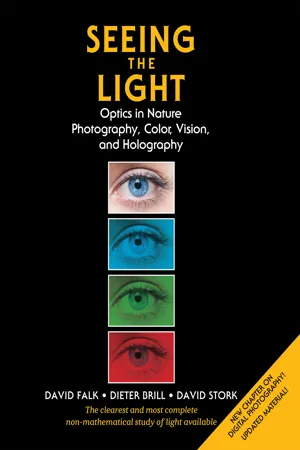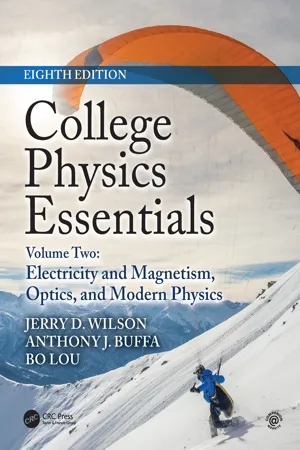Physics
Reflecting Telescopes
Reflecting telescopes use mirrors to gather and focus light, allowing for the observation of distant objects in space. They are designed with a concave mirror that reflects light to a focal point, where it can be viewed or captured by instruments. This design eliminates chromatic aberration and allows for larger apertures, making reflecting telescopes popular for astronomical research.
Written by Perlego with AI-assistance
Related key terms
Related key terms
1 of 4
Related key terms
1 of 3
9 Key excerpts on "Reflecting Telescopes"
- eBook - ePub
Optics
An Introduction
- Sarhan M. Musa(Author)
- 2020(Publication Date)
- Mercury Learning and Information(Publisher)
Telescopes are generally employed to form an image at infinity of an infinitely distant object like a star. They may also be employed, for example, for simple laboratory experiments, to form an image at a finite distance of an object located at a finite distance from it. Telescopes may be conveniently divided into two general classes: (a) those employing lenses as objectives, called refracting telescopes; and (b) those employing mirrors as objectives, called Reflecting Telescopes. These are further subdivided into the astronomical class and the terrestrial class, depending upon whether the final magnified image as seen by the eye is inverted or erect with respect to the object under examination.5.6 THE ASTRONOMICAL REFRACTING TELESCOPEThe optical system of the astronomical refracting telescope is illustrated by Figure 5.6 .FIGURE 5.6. The astronomical telescope.O1 O2 is the objective of a long focal length on which is incident a parallel beam of light from an off-axial distant object point, making an angle i with the axis of the instrument. The objective refracts this beam so that the refracted beam converges at Q′ in the second principal focal plane of the objective. This image, which is real and inverted with respect to the distant object, acts as a real object for the eyepiece, and if the first principal focal plane of the eyepiece coincides with the second principal focal plane of the objective, the so-called normal adjustment, then after refraction by the eyepiece, rays emerge as a parallel beam. The direction of the emergent beam is parallel to the line joining the point Q′ to Oe , the optical center of the eyepiece, because if we imagine the ray Q′Qe to exist, it would emerge from the eyepiece without any deviation from its path. Thus, a virtual magnified image is formed at infinity of the real image P′Q′, the latter being the image of an object and formed due to the refraction through the objective.The objective is at one end of a large tube, while the eyepiece is usually fixed in a smaller tube which is inserted in the larger one at its other end. Thus, the focus can be adjusted to suit any eye. The rim of the objective limits the width of the beam incident on the telescope. As a consequence, the objective itself serves as an entrance pupil of the instrument. A real image of the objective formed by the eyepiece is therefore the exit pupil of the instrument. The ray entering the telescope through the optical center of the objective, which is also the center of the entrance pupil, is called the chief ray, and this ray must finally pass through the center of the exit pupil. Rays entering at the rim of the objective must pass through the conjugate points on the rim of the exit pupil, as illustrated by Figure 5.6 - eBook - ePub
- A Norton(Author)
- 2019(Publication Date)
- CRC Press(Publisher)
Finally, there is the problem of optical aberrations. As you saw earlier, light passing through different parts of a lens is not focused to the same point by spherical surfaces (because of spherical aberration). Even from the same part of the lens, waves of different frequency are focused to different points (due to chromatic aberration). By combining several lenses of different optical strengths and different refractive indexes such aberrations can be reduced. However, the problems are still formidable, and increase with the increasing size of the lenses and with the angle of the rays with respect to the optical axis. Thus, in practice, refracting telescopes have only a relatively narrow field of view within which resolution is good.The net result of all these problems is that refracting telescopes are no longer built for serious astronomical work. You may come across small hobby telescopes built to this design, but in general these are less satisfactory than a pair of binoculars of comparable cost.4.5 The reflecting telescope
A lens is not the only object that can collect and focus light and thus produce visual images. People have known about and used looking glasses (mirrors) for much of recorded history, but it took no less a genius than Isaac Newton to realize how a curved mirror could be used to construct a reflecting telescope, and that this would overcome some of the most important shortcomings of refracting telescopes.A concave spherical mirror will reflect parallel rays approaching along its axis of symmetry so that they come together at one point (the focus) lying between the reflecting surface and its centre of curvature. The main advantage of focusing by reflection is that the angle of reflection is the same for all frequencies in the incident radiation. There is no analogue to the chromatic aberration that takes place in lenses. Hence, if the objective lens of a telescope is replaced by a reflecting spherical objective mirror - eBook - ePub
- James B Kaler(Author)
- 2016(Publication Date)
- WSPC(Publisher)
First, they make stars, planets, etc. brighter by gathering more light than the eye can possibly do alone. Simply put, a telescope is a light bucket that collects starlight with lenses or mirrors and brings it to a focus for the observer to see directly or to record permanently. We can thus see ever-fainter stars, asteroids, galaxies, whatever, just by making the lens or mirror bigger. Telescopes also magnify, making the scene look larger, as can be attested to by anybody who has used binoculars (twin aligned telescopes) at a racetrack or for that matter anywhere else. To the astronomer, magnification refers to the ability to see or resolve fine detail that the eye alone cannot discern. What astronomical telescopes do NOT do is cut the light-travel time from a star or other object to here.The past four centuries since Galileo, and especially the last few decades, have seen a stunning increase in our ability to know the heavens, to probe deeply and with increasing detail into the cosmos. Aided by sensitive detectors, powerful computers, and larger telescopes, we can scan the sky nightly to accumulate so much data that we store it for future generations to mine, so extraordinarily much that data management has become an astronomical specialty. Moreover, we have expanded the concept of “telescope” to cover observation of the entire electromagnetic spectrum, from long wave radio to high energy gamma rays, and of necessity have taken our telescopes into space in order to free us from the blurring and absorptive effects of the Earth’s atmosphere, which blocks much of the electromagnetic spectrum. So here we look at the traditional tools of astronomy and at how we gather the data through which cosmic understanding (or so we think) might be accomplished. And it all started with Galileo’s tiny lens that helped change the world.Refractors and how telescopes work
There are two different kinds of astronomical telescope used in the optical domain, refractors and reflectors, with many variations on the themes. Refractors use lenses, reflectors rather obviously mirrors. Since the refractor is the more familiar of the two, we’ll use it as an example to outline basic properties of telescopes in general. Like Galileo’s, the refractor uses a curved, convex lens (one bowed outward in the middle) called the objective. Stars and the like are so far away that their incoming light rays (or photons) run parallel to one another. The lens’s purpose is to gather the incoming parallel beams of light and converge them toward a focus where they meet. The distance from the objective to the focal point is the focal length, which depends on the curvature of the objective. If you put a screen at the focus perpendicular to the lens’s axis (the focal plane), you’ll see a projected image of the source, be it a field of stars, a planet, or perhaps a distant bird, which will appear inverted, up for down, and left for right. - eBook - ePub
- M. Shane Burns(Author)
- 2021(Publication Date)
- CRC Press(Publisher)
light-gathering power of an optical telescope is proportional to the area of the objective lens. Galileo was able to see the moons of Jupiter for the first time because his telescope had sufficient light-gathering power, not because of the magnification of his telescope. If the Galilean moons of Jupiter were brighter they could be resolved as separate from Jupiter with the naked eye.Galileo did his observations using his eye as a light detector. Today, virtually all astronomical observations are done using a solid state device like a CCD (see Chapter 4 ) as the detector. Instead of using an eyepiece the detector is placed at the focal plane of the objective lens and the image is produced directly on the detector. The focal plane is a plane through the focal point and perpendicular to the optical axis. The simplest telescope is just a lens and a detector.One problem with refracting telescopes is that since the index of refraction depends on wavelength different colors of light come to a focus at different points. This makes it impossible to obtain a perfect focus. If the lenses are adjusted so that the red light is in focus, the blue light is out of focus and visa versa. This effect is called chromatic aberration. Chromatic aberration can be reduced, but not completely eliminated by using compound lenses, lenses that are made of two or more pieces of glass with different indices of refraction.2.1.3 Mirrors
A better way to avoid chromatic aberration is to use curved mirrors to redirect light rays. Most modern astronomical telescopes use mirrors to gather and focus light. Mirrors with spherical surfaces are easy to analyze and fabricate so we will consider them first. Figure 2.9 shows the cross section of a concave spherical mirror of radius r. A ray starting at point O is reflected from the mirror at point P and passes through the point I. The optical axis of the mirror is defined by the points O, C, and I. Point C is at the center of the spherical surface that forms the mirror. The interior angles of the triangle OCP must add up to π soα + ( π − β ) +orθ I= πα +. Likewise for the triangle OIP,θ I= βα + ( π − γ ) + (orθ I+θ R) = πα +. The law of reflection requires thatθ I+θ R= γθ I=θ R - eBook - ePub
Solar Planetary Systems
Stardust to Terrestrial and Extraterrestrial Planetary Sciences
- Asit B. Bhattacharya, Jeffrey M. Lichtman(Authors)
- 2016(Publication Date)
- CRC Press(Publisher)
19The Telescope—The Essential Tool
19.1 Introduction
In this chapter, we discuss the telescope evolution, their properties, and function of telescopes from Galileo to NASA’s Great Observatories [1 , 2 and 3 ]. In addition, we talk about some of the supporting instrumentation as well as some new programs and discoveries. Figure 19.1 illustrates a rough timeline of telescope technology.Space science researchers of NASA control some of the most sophisticated space probes and orbiting telescopes to get images of objects in space which we have also summarized.19.2 Lippershey and Galileo’s Refracting Telescope
In 1608—Hans Lippershey applies for a patent for the first recorded functional refractor telescope. A year later in 1609, Galileo refractor used two lenses for the purpose of concentrating the light from celestial objects. The system was designed in a manner so that it can deliver more light to the human eye than it can gather on its own. The light was refracted through a lens of spherical shape, forming an image. The spherical primary lens made the images blurry. The lens also split light into colors, producing a fringe of color around bright objects. A simple arrangement of the refracting telescope is shown in Figure 19.2 .As shown in Figure 19.2 , the parallel light rays from the star are collected by the primary lens which is a convex spherical lens. After passing through the lens light is being concentrated on a small area on a concave eyepiece (parallel light rays) lens and then to the observer’s eye.19.2.1 Kepler’s Design for an Improved Refractor
A spherical-type lens brings light rays to different focal points, causing blurry images. Kepler constructed a less curved spherical “primary lens” with a larger “focal length” than Galileo had used (1611). The less curved lens would make light rays move farther before they crossed thus bringing the focal points closer together. This improvement made the fuzzy image sharper. - eBook - ePub
- Ian Morison(Author)
- 2013(Publication Date)
- Wiley(Publisher)
Thus the eye has a theoretical resolution of about 1 arcmin (1/60th of a degree). This image falls upon the retina where it is sampled by the rods and cones. If there were an insufficient number of these, the resolution would be compromised, but evolution has ensured that this is not a limiting factor! If we have a telescope with a magnification of ×60 it means that we could see detail about 1 arcsec across. It is rare that the atmosphere will allow us to see detail finer than this so one might say that ×60 is all that you need. In fact, spreading out the image on the retina helps so a magnification of ×120 – ×200 will usually let us see more detail.5.6 Image contrast
In any telescope, some light will fall in areas of the image where it should not – turning black into dark grey. This light has been scattered by the surfaces of lenses and mirrors in the telescope and stray light can be reflected from the sides of the telescope tube. Mirrors are worse than lenses in this respect and it is harder to efficiently baffle (to intercept stray light) a reflecting telescope than a refractor. So refractors tend to give the highest contrast images. Many manufacturers can now provide mirrors with high reflectivity coatings. These will allow slightly fainter objects to be seen but, more importantly, by reducing the light scattered at mirror surfaces, they will have a marked effect on image contrast.5.7 The classic Newtonian telescope
The Newtonian telescope was invented by Sir Isaac Newton who did not believe that one could overcome the problem of chromatic aberration that was suffered by simple refracting telescopes of the time. Sadly, it is not thought that he made any astronomical observations with it. In the Newtonian, a primary mirror reflects the light to a focus that would lay in the centre of the tube so, to avoid obstructing the light path with the head, a secondary mirror, often called the flat, reflects the light sideways to form an image just outside the tube where the focuser and eyepiece are placed. As the secondary mirror has to intercept the converging light cone at an angle of 45° it must have an elliptical outline with its major axis 1.414 (the square root of 2) times longer than its minor axis. - eBook - ePub
Seeing the Light
Optics in Nature, Photography, Color, Vision, and Holography (Updated Edition)
- Joan G. Thomas, David Falk, Dieter Drill, David Stork(Authors)
- 2018(Publication Date)
- Echo Point Books & Media(Publisher)
Here use the f ≃ -5-cm lens as the eyepiece, and the f ≃ 20-cm lens as the objective. The spacing between the lenses should be about 20 cm 5 cm = 15 cm. Try to look at the same object as you did with the refracting astronomical telescope. The image should now be erect. How do the magnifications compare in the two cases? How about the angle of view? Reverse the positions of the two lenses and look through them. Notice the wide angle of view, useful for a peephole in a door. (Of course, unless you live in a castle, you probably don’t have doors 15 cm thick. Actual peepholes use shorter focal length lenses.)C. Reflecting Telescopes
The preceding telescopes all use objective lenses (so-called refracting telescopes). Large diameter lenses, however, create numerous problems. Their aberrations (particularly chromatic) are difficult to correct and they tend to sag under their own weight because they can only be supported by their edges. A technique that avoids all these difficulties is to use a concave, focusing mirror as the objective (the so-called primary mirror). Because no refraction is involved, mirrors have no chromatic aberration. They can be supported over their entire back, and because they are front-surface mirrors, the back of the glass can even be honeycombed to reduce the weight. A smaller, secondary mirror is normally used to enable you to look through the telescope without getting your head in the way of the incoming beam. There are a variety of such Reflecting Telescopes, a few of which are pictured in Figure 6.16 . In the very large Reflecting Telescopes, the astronomer (or her film) can actually sit at the focal point of the primary mirror (Fig. 6.17 ). The largest reflecting telescope is in Zelenchukskaya, Soviet Union, with a 6-meter objective.A new technique to avoid the weight and cost of a single large mirror is to use a number of smaller mirrors in concert. (While we have called this technique new, it is similar to the one ascribed to Archimedes. See Sec. 3.3D .) The light collected by each of the separate mirrors is focused to a common image. The mirrors’ sensitive alignment is accomplished by means of laser beams that accurately detect each mirror’s position, computers that rapidly calculate any required position change, and motors that continually realign the mirrors. The Multiple Mirror Telescope - eBook - ePub
Optics and Optical Instruments
An Introduction
- B. K. Johnson(Author)
- 2012(Publication Date)
- Dover Publications(Publisher)
5 cm. from the rear lens of the erector. Now return to the erector system and proceed to insert between the lenses a diaphragm, the position and size of which is important; to determine this, illuminate the whole area of the object glass by means of a diffuse source of light and find the position of a ground glass screen placed between the erector lenses so that a sharp image of the O.G. is formed on the latter. Record the position on the bench and measure the diameter of the image, which will be found to be about 7 mm. Remove the ground-glass screen and replace it by a diaphragm with the above diameter hole in it. The terrestrial telescope is now complete and by viewing through the instrument, the image of distant objects will be seen to be correctly erected and reversed.Reflecting Telescope.
In order to illustrate in practice the principle of the reflecting telescope, the Newtonian form of this instrument may be set up with the aid of the optical bench, as this is easier to demonstrate than the Gregorian or Cassegrain types, which require an opening through the main mirror.FIG. 63 .Reflecting Telescope.Fig. 63 shows the arrangement of the optical parts: M is a surface-silvered mirror of about 40 cm. radius. Strictly this should be of parabolic form, but for small apertures a spherical mirror will be found quite satisfactory; and, indeed, a silvered concave spectacle lens mounted in one of the fittings may be utilized for this purpose. At about 17 cm. from the mirror is mounted a small diagonal plate P (surface-silvered) to reflect the convergent beam out at right angles to the eyepiece which observes the image at I. The whole may then be directed towards a distant object and used as a complete telescope. The improvement in the chromatic aberration will be noted when compared with the model telescopes made up with a single lens utilized as the object glass.Measurements on Manufactured Telescopes.
Whilst the foregoing experiments in this chapter are intended to illustrate the broad principles of the telescope, the measurements and tests on the commercially manufactured instrument may need slight modification from those already described.FIG. 64 - eBook - ePub
College Physics Essentials, Eighth Edition
Electricity and Magnetism, Optics, Modern Physics (Volume Two)
- Jerry D. Wilson, Anthony J. Buffa, Bo Lou(Authors)
- 2019(Publication Date)
- CRC Press(Publisher)
Figure 25.13 ). A parabolic mirror does not exhibit spherical aberration, and a mirror has no inherent chromatic aberration. (Section 23.5; why?) High-quality glass is not needed, because the light is reflected by a mirrored surface. Only one surface has to be ground, polished, and silvered.▲ Figure 25.13 Reflecting Telescopes A concave parabolic mirror can be used in a telescope to converge light to form an image of a distant object. (a) The image may be at the prime focus, or (b) a small mirror and lens can be used to focus the image outside the telescope, a configuration called a Newtonian focus .The largest optical reflecting telescope, with two mirrors, each 8.4 m (27 ft) in diameter, is the Large Binocular Telescope (LBT) in Mount Graham International Observatory, Arizona, USA (▼ Figure 25.14a ).▲Figure 25.14Large Reflecting Telescopes (a) Two 8.2-m-diameter mirror for the Large Binocular Telescope, in Mount Graham, Arizona. (b) Seven 8.4-m diameter mirrors forming a single primary mirror with an effective mirror diameter of 24.5 m (80 ft) is planned for the Giant Magellan Telescope (GMT).Even though Reflecting Telescopes have advantages over refracting telescopes, they do have their own problems. Like a large lens, a large mirror may sag under its own weight. The weight factor also increases the costs of construction, because the supporting elements for a heavier mirror must be more massive.These problems are being addressed by new technologies. One approach is to use an array of mirrors, coordinated to function as a single large mirror. Examples include the European Southern Observatory’s four 8.2-m-diameter mirrors linked to form a VLT (Very Large Telescope) with an equivalent diameter of 16 m. The Giant Magellan Telescope (GMT) is planned to be completed in 2025. Seven 8.4-m diameter mirrors will form a single primary mirror with an effective mirror diameter of 24.5 m or 80 ft (Figure 25.14b
Index pages curate the most relevant extracts from our library of academic textbooks. They’ve been created using an in-house natural language model (NLM), each adding context and meaning to key research topics.
Explore more topic indexes
Explore more topic indexes
1 of 6
Explore more topic indexes
1 of 4
